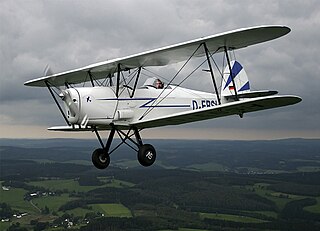| Active | |
|---|---|
 | |
| Arrow Active 2 | |
| Role | Aerobatic sports aircraft |
| Manufacturer | Arrow Aircraft Ltd. |
| Designer | A. C. Thornton |
| First flight | 1931 |
| Number built | 2 |
The Arrow Active is a British aerobatic aircraft built in the 1930s.
| Active | |
|---|---|
 | |
| Arrow Active 2 | |
| Role | Aerobatic sports aircraft |
| Manufacturer | Arrow Aircraft Ltd. |
| Designer | A. C. Thornton |
| First flight | 1931 |
| Number built | 2 |
The Arrow Active is a British aerobatic aircraft built in the 1930s.
In 1930, Arthur Cecil Thornton, previously an aircraft designer with Blackburn Aircraft, set up his own company, Arrow Aircraft, at Leeds, Yorkshire, to develop his ideas for a single-seat aerobatic aircraft and advanced trainer. [1] The resulting design, the Arrow Active was a single-seat biplane of conventional configuration, with single-bay, staggered wings of unequal span and chord, bordering on being a sesquiplane. The upper and lower wings are joined by a single interplane strut. The undercarriage is fixed, with a pair of mainwheels and a tail-skid. It was originally powered by a 115 hp (86 kW) Cirrus-Hermes IIB engine.
The second aircraft built featured a more powerful 120 hp (90 kW) de Havilland Gipsy III and was designated Active 2. It also differed from the Active 1 in having a strutted, conventional centre section, a slightly different shaped fin and rudder, and smaller, wider wheels.
Although it was originally hoped [2] that the military might show an interest in the aircraft, this did not transpire, and the Active was flown as a sports plane. The Active 1 G-ABIX received its Certificate of Airworthiness on 21 May 1931 [3] and flew at 132.2 mph (212 km/h) in the 1932 King's Cup Race. It was Alex Henshaw's mount in the second half of 1935 until severely damaged in a crash following an in-flight fire that December.
The Active 2 G-ABVE was certified on 29 June 1932 [4] and flew in the King's Cup in both 1932 and 1933. Slightly faster than the Arrow 1, it recorded a speed of 137 mph (220 km/h)
Rebuilt in 1958, and again in 1989, the Active 2 is still on the British civil register and is based at Coventry, England. [6] [ citation needed ]

Data from [7]
General characteristics
Performance

The de Havilland DH.60 Moth is a 1920s British two-seat touring and training aircraft that was developed into a series of aircraft by the de Havilland Aircraft Company.

The Miles M.38 Messenger is a British four-seat liaison and private owner aircraft built by Miles Aircraft.

The Stampe et Vertongen SV.4 is a Belgian two-seat trainer/tourer biplane designed and built by Stampe et Vertongen. The aircraft was also built under licence in France and French Algeria.

The Foster Wikner Wicko was a 1930s British two-seat cabin monoplane built by the Foster Wikner Aircraft Company Limited at Southampton Airport, Hampshire.

The Parnall Heck was a 1930s British four-seat cabin monoplane built by Parnall Aircraft Limited at Yate, Gloucestershire. Originally a Hendy design, few were built. It combined the strength and comfort of a cabin aircraft with the speed of a racer.

The Auster J/1 Autocrat was a 1940s British single-engined three-seat high-wing touring monoplane built by Auster Aircraft Limited at Rearsby, Leicestershire.

The Auster J/5 Autocar was a late 1940s British single-engined four-seat high-wing touring monoplane built by Auster Aircraft Limited at Rearsby, Leicestershire.

The Auster J/5 Aiglet Trainer was a 1950s British single-engined four-seat high-wing training and touring monoplane built by Auster Aircraft Limited at Rearsby, Leicestershire.

The Miles M.28 Mercury was a British aircraft designed to meet the need for a training and communications plane during the Second World War. It was a single-engined monoplane of wooden construction with a twin tail and a tailwheel undercarriage with retractable main units.

The Miles Hawk Major was a 1930s British two-seat light monoplane, developed by Miles Aircraft from the Miles Hawk in order to take advantage of the new inverted de Havilland Gipsy Major engine. When fitted with the longer Gipsy Six in place of the forward crew member, it was known as the Miles Hawk Speed Six.

The Miles M.3 Falcon is a 1930s British three/four-seat cabin monoplane aircraft designed by Miles Aircraft Limited.

The Elliotts of Newbury EoN or Elliotts EoN A.P.4 was a 1940s British four-seat touring monoplane aircraft built by Elliotts of Newbury.

The General Aircraft Monospar was a 1930s British family of touring and utility aircraft built by General Aircraft Ltd (GAL).

The Auster J/1B Aiglet is a British light civil utility aircraft developed in the 1950s.
The CLW Curlew was a two-seat, single-engined training aircraft built partly to demonstrate a new wing structure. It flew successfully in the UK in 1936, but the company went bankrupt and only one Curlew flew.
The British Aircraft Cupid was a two-seat, single-engined monoplane, a smaller version of the B.A. Eagle designed for touring and training. Only one was built.

The Comper Streak was a single-engined, single-seat racing monoplane built in the UK in the mid-1930s. It was not successful as a racer and only one was produced.
The Surrey Flying Services AL.1 was a single-engined side-by-side two-seat training biplane, built at a UK flying club in 1929. Only one was built, but it was flying until the outbreak of war in 1939 and remains in storage.
The Pobjoy Pirate was a three-seat, high-wing monoplane designed to compete with the de Havilland Leopard Moth using a low power but light Pobjoy radial engine. Flight tests showed the Pirate to be uncompetitive and its development was rapidly abandoned.

The Auster J series was a family of British light civil utility aircraft developed in the 1940s and 50s by Auster at Rearsby, Leicestershire.